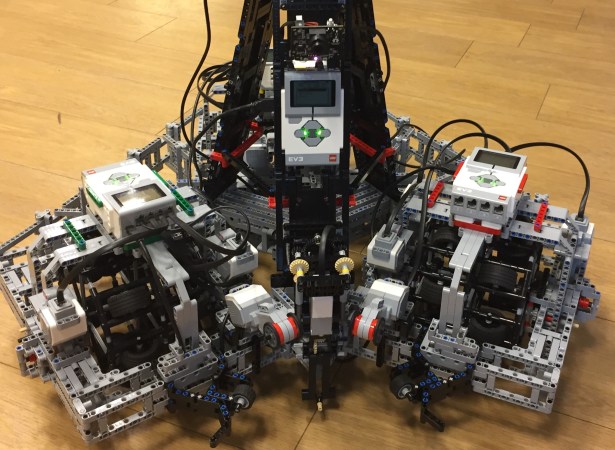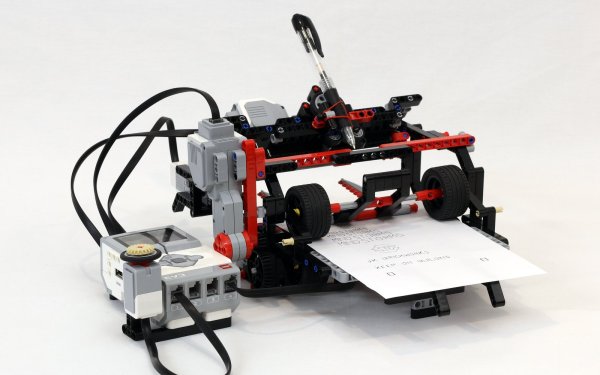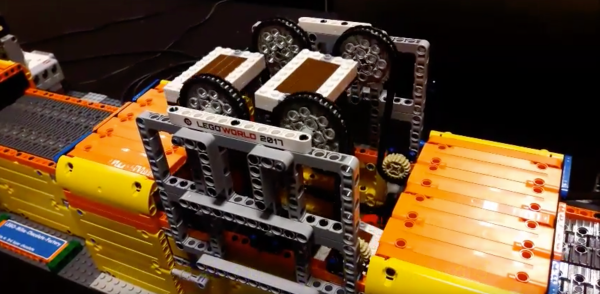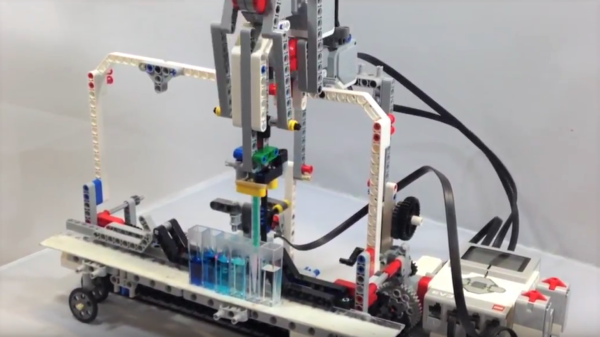[Bram], a 17-year-old robot fan from the Nertherlands, had an opportunity to watch a RoboCup soccer match played by autonomous robots, and was inspired to create his own Mindstorms version of the robot for a school project.
The robot he created is around 80 cm in diameter and is controlled by four daisy-chained EV bricks. There are nine large motors for controlling the wheels, two more large motors for grabbing the ball, and two medium motors for the ball-shooting mechanism. It uses a Pixycam for ball detection, and it can identify and move toward the ball so long as it’s within 2.5 m. A gyro sensor determines the robot’s rotational direction.
 Our favorite detail of the robot is its giant omni wheels, constructed out of LEGO elements. Each one consists of sixteen Mindstorms-standard wheels arranged in a circle, with an offset double row of rollers to give the same angled effect as a Mechanum wheel’s rollers.
Our favorite detail of the robot is its giant omni wheels, constructed out of LEGO elements. Each one consists of sixteen Mindstorms-standard wheels arranged in a circle, with an offset double row of rollers to give the same angled effect as a Mechanum wheel’s rollers.
This story has even geekier roots. [Bram]’s robot was based off of the Turtle, a soccer-playing robot used to teach programming to college students. Like [Bram]’s creation, they also have omni wheels, and see with a Kinect as well as a 360-degree camera up top that uses a parabolic mirror to keep an eye on its surroundings. The Turtle uses a compass sensor to distinguish its goal from the opposing team’s goal.
We’ve covered soccer bots in the past, watch a soccer-playing robot score on a human goalie.
Continue reading “Mindstorms Soccer Robot Inspired By Real Soccer Robot”










 [Wilfred] was testing a titanium 3D printer at work and was looking for something to print. The skull ‘n wrenches was a suitable candidate, and the results are fantastic. From [Wilfred]: “Just out of the printer the logo looks amazing because it isn’t oxidized yet (inside the printer is an Argon atmosphere) Then the logo moves to an oven to anneal the stress made by the laser. But then it gets brown and ugly. After sandblasting we get a lovely bluish color as you can see in the last picture.”
[Wilfred] was testing a titanium 3D printer at work and was looking for something to print. The skull ‘n wrenches was a suitable candidate, and the results are fantastic. From [Wilfred]: “Just out of the printer the logo looks amazing because it isn’t oxidized yet (inside the printer is an Argon atmosphere) Then the logo moves to an oven to anneal the stress made by the laser. But then it gets brown and ugly. After sandblasting we get a lovely bluish color as you can see in the last picture.”









